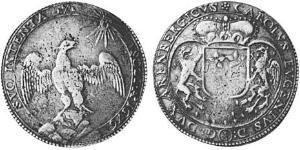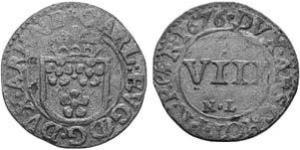| preceded by | |
|
|||||||||
|
|
|||||||||
| County of Arenberg (1549 - 1810)from the Wikipedia | Read original article |
|
|
This article may require cleanup to meet Wikipedia's quality standards. (May 2010) |
| County (Duchy) of Arenberg | ||||||
| Grafschaft (Herzogtum) Arenberg | ||||||
| State of the Holy Roman Empire, then State of the Confederation of the Rhine |
||||||
|
||||||
|
||||||
| Capital | Aremberg | |||||
| Government | Principality | |||||
| Historical era | Middle Ages | |||||
| - | County established | ca 1177 | ||||
| - | Gained Reichsfreiheit | 1549 | ||||
| - | Raised to Princely county | 1576 | ||||
| - | Joined Council of Princes | 1580 | ||||
| - | Raised to Duchy | 1644 | ||||
| - | Joined Confederation of the Rhine |
1806 |
||||
| - | Mediatised to Hanover and Prussia |
1810 1810 |
||||
| Area | ||||||
| - | 1798 | 413 km² (159 sq mi) | ||||
| Population | ||||||
| - | 1798 est. | 14,800 | ||||
| Density | 35.8 /km² (92.8 /sq mi) | |||||
Arenberg, also spelled as Aremberg or Ahremberg, is a historic county, principality and finally duchy located in modern Germany. The Dukes of Arenberg remain a prominent Belgian aristocratic family.
Contents
History[edit]
First mentioned in the 12th century, it was named after the village Aremberg in the modern district of Ahrweiler, in the Rhineland-Palatinate.
1549–1576[edit]
Aremberg was originally a county. It became a state of the Holy Roman Empire (reichsunmittelbar) in 1549, was raised to a principality in 1576, and finally a duchy in 1645.
1789[edit]
The territorial possessions of the dukes of Arenberg varied through the ages. Around 1789 the duchy was located in the Eifel region on the west side of the Rhine, and contained amongst others Aremberg, Schleiden and Kerpen.
However, although the Duchy itself was in Germany, from the 15th century on, the principal lands of the Dukes of Arenberg have been in modern day Belgium.
The pre-Napoleonic duchy had an area of 413 km² and a population of 14,800. It belonged to the Electoral Rhenish Circle, and was bordered by the duchy of Jülich, the Archbishopric of Cologne, the Archbishopric of Trier, and the county of Blankenheim.
1798[edit]
After the French occupation of the west bank of the Rhine around 1798 (see Treaty of Campo Formio and Treaty of Lunéville) the duke of Arenberg received new lands: the county of Vest Recklinghausen, the county of Meppen, and the lordship of Dülmen.
1810[edit]
Arenberg joined Napoleon's Confederation of the Rhine, although that did not prevent it being mediatised in 1810, with France annexing Dülmen and Meppen, and the duchy of Berg annexing Recklinghausen.
1814[edit]
After Napoleon's defeat in 1814 and the dissolution of the Confederation of the Rhine the former Arenberg territories were divided between the kingdom of Prussia and the kingdom of Hanover. Both in Prussia and Hanover, the dukes became local peers subordinate to the king.
1826[edit]
In 1826, the Arenberg territory in Hanover was named duchy of Arenberg-Meppen. Arenberg-Meppen had an area of 2,195 km² and a population of 56,700. The county of Recklinghausen, in Prussia, had an area of 780 km² and a population of 64,700.
The dukes of Arenberg remain a prominent Belgian aristocratic family. The direct family of the reigning duke are called by the nominal title of prince of Arenberg. The ducal family descends agnatically from the House of Ligne.
The forest of Arenberg is located in northeastern France, and is famous for its cobbled roads used in the classic road cycle race Paris–Roubaix. Its areas saw extensive mining in the past.
Counts, Princely Counts and Dukes[edit]
Counts of Arenberg (1117–1576)[edit]
- Franko (1117–1129)
- Henry I (1136–1187)
- Eberhard I (1188–1202)
- Eberhard II (1202–1229)
- Henry II (1220–1250)
- Gerard (1252–1260)
- John I (1260–1279)
- Mathilde (1282–1299)
- Eberhard (Count of Marck) (1282–1308)
- Eberhard I (III) (1308–1387)
- Eberhard II (1387–1454)
Partition into Arenberg and Rochefort
- John II (1454–1480)
- Eberhard III (1480–1496)
- Eberhard IV (1496–1531)
- Robert I (1531–1541)
- Robert II (?–1536)
- Robert III (1541–1544)
- Margaret (1544–1576)
- John III (1547–1568)
- Charles (1568–1576)
Princely Counts of Arenberg (1576–1645)[edit]
- Margaret (1576–1596) with Jean de Ligne
- Charles (1576–1616)
- Philip Charles (1616–1640)
- Philip Francis (1640–1645)
Dukes of Arenberg (1645–1810)[edit]
- Philippe François, 1st Duke of Arenberg (1645–1675)
- Charles Eugene, 2nd Duke of Arenberg (1675–1681)
- Philip Charles Francis, 3rd Duke of Arenberg (1681–1691)
- Leopold, 4th Duke of Arenberg (1691–1754)
- Charles Marie Raymond, 5th Duke of Arenberg (1754–1778)
- Louis Engelbert, 6th Duke of Arenberg (1778–1803)
- Prosper Louis, 7th Duke of Arenberg (1803–1810)
Mediatised 1810
Non-reigning dukes of Arenberg (1810–present)[edit]
- Prosper Louis, 7th Duke of Arenberg (1810–1861)
- Engelbert Auguste, 8th Duke of Arenberg (1861–1875)
- Engelbert-Marie, 9th Duke of Arenberg (1875–1949)
- Engelbert-Charles, 10th Duke of Arenberg (1949–1974)
- Erik Engelbert, 11th Duke of Arenberg (1974–1992)
- Jean Engelbert, 12th Duke of Arenberg (1992–2011[1])
- Léopold, 13th Duke of Arenberg (2011–present)
See also[edit]
References[edit]
Sources[edit]
External links[edit]
|
|||||||||||||||||
|
|||||||||||||||||||||||||||||||||||||||||||||||||||












